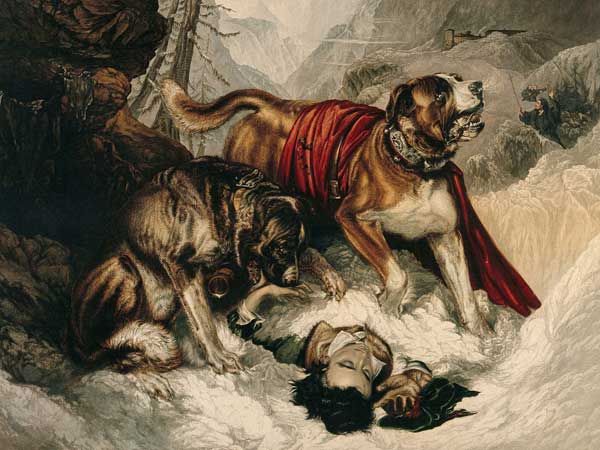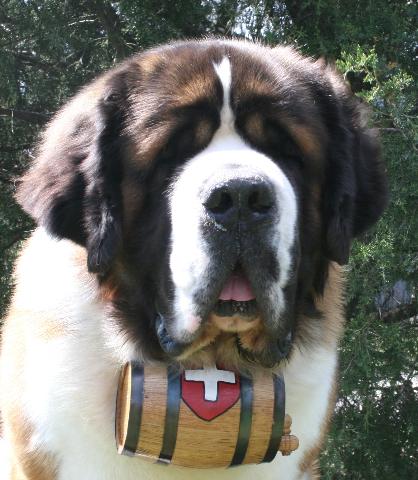Legend tells that Saint Bernards carried barrels of whiskey around their necks to aid stranded travelers.
In order to help travelers, an Augustine monk named St. Bernard de Menthon founded a hospice and monastery around the year 1050. Sometime between 1660 and 1670, the monks at Great St. Bernard Hospice acquired their first St. Bernards. The breed they raised were descendants of the mastiff style Asiatic dogs brought over by the Romans. They were smaller than modern St.Bernards and had shorter reddish brown and white fur with a longer tail. The earliest image of their dogs was depicted in two paintings done by well-known Italian artist Salvatore Rosa in 1695.
At first, the dogs were companions to guides called “marrioners” that helped bring travelers between the hospice and Bourg-Saint-Pierre, a municipality on the Swiss side of the pass. (The pass was 49 miles long and at least 8,000 miles above sea level) Later, the dogs’ amazing abilities to sense avalanches, locate stranded travelers, and sniff out people buried in the snow led the monks to send out packs of two or three dogs alone to seek people out.
When the St. Bernards would locate and dig a person out, one dog would lay on top of the person and the other dog would go for help. (Think Lassie!) This would be where those barrels of whiskey would come in handy to warm the stranded person and help ward of the freezing temperatures. Unfortunately, there is no documentation that the dogs ever carried the whiskey barrels! There is a painting from 1820 by Sir Edwin Henry Landseer that shows two dogs saving a man in the snow and one has a barrel around its neck. It is believed that the artist was being creative, because there is no proof that this practice was used by the monks or the dogs. If you ask me, it doesn’t matter much whether it was true or not. If people imagined that the dogs were saving people with the aid of whiskey, the fact that the use of the barrels was believed to be true and is now part of their legend is enough. The use of whiskey as medicine was not a new concept and it only made sense that whiskey would be part of a rescue operation! It just goes to show that it was a believable idea.
The dogs were responsible over 150 years for rescuing more than 2000 people. The story goes that the system was so successful that when Napoleon and his 250,000 soldiers crossed through the pass between 1790 and 1810, not one soldier lost his life. One famous St. Bernard, Barry, (lived in the monastery from 1800-1812) saved the lives of more than 40 people. In 1815, Barry’s body was put on exhibit at the Natural History Museum in Berne, Switzerland, where it remains today.
The breed almost went extinct between the horrible winters of 1816 and 1818, when many dogs perished in the snow. The monks were able to save the breed by replenishing their numbers with similar dogs from neighboring valleys. In the 1830’s the monks started cross breeding their dogs with Newfoundlands in an effort to give them more fur for warmth. Unfortunately, ice formed on the hair and the dogs were no longer effective in rescues. That spelled the end of their usefulness in the mountains but created a breed that would become famous as a companion and pet. St. Bernard owners today can buy those barrels for their dog- some of them even successfully hold whiskey!


